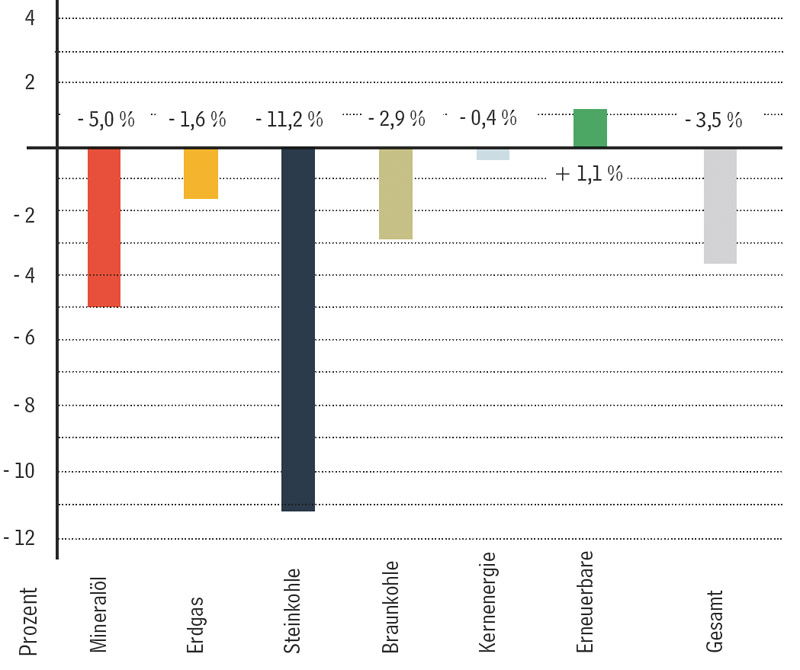Germany’s energy consumption in 2018 fell to its lowest level since the early 1970s. With a total volume of 12,963 PJ or 442.3 Mtce, consumption was 3.5 % below the previous year’s level (Figure 1). As outlined by Arbeitsgemeinschaft Energiebilanzen (AG Energiebilanzen – Working Group on Energy Balances), Berlin/Germany, in its 2018 Annual Report published at the end of March, this development is due to significantly higher energy prices, the mild weather and a big increase in energy productivity. In contrast, the consumption-enhancing factors of economic development and population growth receded into the background. According to calculations by AG Energiebilanzen, energy consumption would have decreased by 2.4 % without the consumption-reducing impact of the mild weather.

Fig. 1. Development of primary energy consumption in Ger-many 2018: Changes as a percentage. 12,963 PJ or 442.3 Mtce
in total. Source: AG Energiebilanzen
When it comes to the development of consumption last year, one of the surprises was the sharp increase in macroeconomic energy productivity by 5.2 % (temperature-adjusted: + 4.0 %). This parameter for the efficient use of energy is calculated from the energy input per unit of economic performance. The long-term average value of this parameter is approximately 2 %.
The development of consumption, but also structural changes in the energy mix resulted in energy-related CO2 emissions in Germany decreasing by about 34 Mt in 2018. This is a decline of 4.8 % compared to the previous year. Even when taking the temperature effect into account, the reduction is still significant at almost 4 % or about 27 Mt.
In 2018, mineral oil consumption in Germany decreased by a total of 5.0 % to 4,443 PJ (151.6 Mtce). Except for aviation fuels, all mineral oil products recorded a decline. Consumption of diesel fuel went down by 3.1 %, petrol recorded a decrease of 1.4 %. At 16 %, the decline in the sales of light fuel oil was exceptionally sharp. However, there are indications that consumers used up their own stocks first in light of the high prices, and that the actual consumption was higher than the sales in the trade sector. When it comes to aviation fuels, an increase of 2.3 % was recorded for consumption.
Natural gas consumption peaked at 3,071 PJ (104.8 Mtce) in 2018 and was therefore 1.6 % below the previous year’s value. The primary reason for this decline was the reduced use of natural gas for heating purposes because it was about 7.5 % warmer than in 2017 and 12.3 % milder than the long-term average. Towards the end of the year, the cutback in production in the chemical industry resulted in a declining demand for natural gas. In addition, less natural gas was used for power generation in 2018.
There was a sharp decline in the consumption of hard coal once again. Compared to 2017, consumption decreased by 11.2 % to 1,301 PJ (44.4 Mtce). It thus attained the lowest level in German post-war history. The use of coal for the generation of power and heat went down by 16 % to about 26 Mt. In 2018, almost 59 % of the hard coal volume in Germany was used for the generation of power and heat. The downward trend reflects the expansion of the use of renewable energy sources in power generation, which is increasingly replacing the electricity obtained from hard coal and led to a number of power station units being decommissioned in 2018. The use of hard coal in the steel industry decreased slightly by just under 2 % to 17.3 Mt in 2018. Industrial hard coal mining was discontinued in Germany at the end of 2018. In the future, Germany will satisfy its demand for hard coal and coke entirely through imports.
Lignite consumption peaked at 1,465 PJ (50.0 Mtce), meaning that consumption decreased for the sixth time in a row. The decline was 2.9 % due to the decreasing use of lignite for power generation. By 2020, the use of lignite for power generation will decrease by a total of 13 % compared to 2015 on account of the transfer of power stations to standby mode for backup purposes.
Nuclear energy recorded a slight decline of 0.4 %. All told, nuclear energy still contributed a share of 829 PJ (28.3 Mtce) to the energy balance in 2018.
Renewable energy benefited from the installation of additional capacity – specifically in photovoltaics – as well as from the extreme weather conditions experienced at times. The contribution made by renewable energy to total energy consumption increased by 1.1 % to 1,809 PJ (61.7 Mtce). The number of sunshine hours reached a record level, so the total use of solar energy increased by 16.5 %. Wind energy also experienced a record year. It increased its share in the energy balance by 5.6 %. In contrast, the extremely low level of precipitation caused hydropower (without pumped-storage reservoirs) to drop by almost one fifth. Biomass, whose share in the contribution of renewable energy is currently 53.6 %, recorded a decrease of 2 %, which was primarily due to the milder weather. Geothermal energy remained at the previous year’s level.
Renewable energy was able to expand its share in the energy mix for 2018. Biomass, solar energy, wind energy, hydropower, geothermal energy, and the biogenic share of waste accounted for a total of 14.0 % of the entire domestic energy consumption. The most important energy source continued to be mineral oil with a share of 34.3 %, followed by natural gas with 23.7 %. Hard coal accounted for a share of 10.0 % and lignite for 11.3 %. The contribution of nuclear energy accounted for 6.4 %.
Domestic energy production recorded a 2.8 % decline to 3,891 PJ (132.8 Mtce) in 2018. While renewable energy sources increased their contribution to domestic energy production by almost 1 %, all other energy sources recorded a decline. With a decrease of almost 30 %, the decline in domestic hard coal production, which was completely discontinued by the end of 2018, was particularly high. Domestic natural gas production decreased by 12.6 % and mineral oil accounted for a decline of around 7 %. Domestic lignite production went down by 2.9 %. Overall, energy production from domestic resources was able to cover 30 % of total consumption. Today, the most important domestic energy source is renewable energy with a proportion of 46.3 % (previous year: 44.6 %). This is followed by lignite at 38.4 % (previous year: 38.5 %). The shares of other energy sources are in the low single-digit range.
Germany has to meet around 70 % of its demand for energy through imports. Russia has become the most important supplier by far. In 2018, 36.3 % of German crude oil imports came from Russia. Together with the other states of the former Soviet Union (CIS), the share is actually almost 53 %. When it comes to hard coal, supplies from Russia account for a share of about 40 %. Due to the considerable increase in energy prices, the import bill for coal, natural gas and oil went up by approximately one fifth to almost 68 bn € in 2018 when compared to the previous year.
The detailed report on the development of primary energy consumption in 2018 is available at the AG Energie-bilanzen website: www.ag-energiebilanzen.de. (AG Energiebilanzen)/Si.)


